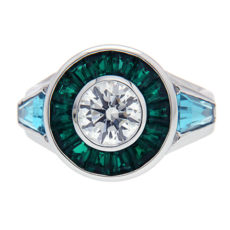The idea of pear-cut diamonds was born in the
1400s. Centuries have gone by, yet the romance and popularity around this
beautiful diamond still sustain. Lodewyk van Berquem was the diamond cutter who
invented the unique wheel to polish every facet of a diamond. This process
became a turning point in the history of diamond cutting as it gave birth to an
exceptionally shaped diamond that exhibited superb sparkle and light return.
What is a pear-cut diamond?
The pear shaped diamond is also known as the
pendeloque cut or teardrop diamond. The outline makes it different from other
familiar diamond cuts. It is regarded as a modified brilliant-cut as it blends
the two worlds of oval and marquise cuts with a pointed end and a rounded curve
on the other. The signature silhouette of a pear is instantly recognizable and
much loved by connoisseurs.
Should I choose a pear
cut diamonds?
Pear has increasingly become fashionable owing to
its unconventional shape and intense sparkle. The pear shares its faceting
patterns with that of a round brilliant. Thanks to this, a pear retains that
much-loved brilliance and fire that make a diamond shine.
The shape of a pear is versatile as the diamond can
be well-adorned with its tip pointing either downwards or upwards. The pear is
all about juxtapositions. The shape is dynamic as it makes a great contemporary
statement while being classy as it is. Celebrities and fashionistas have
adopted this fascinating contour with much zeal. Hence, pear diamond engagement
rings have been rising higher in the popularity chart.
What should you notice when buying a pear-cut
diamond?
The Bow-tie effect is the most dreaded quality in a
pear-shaped diamond. It creates a region of darkness in the middle of a poorly
cut pear diamond. Appearing in the form of a bow tie, this dark zone located at
the center of a pear diamond drastically reduces its flawless, sparkling
appearance.
While experts and admirers agree that the bow-tie
effect is integral to a pear diamond's many features, any severe effect is
still undesirable. When buying a pear-cut diamond, try to inspect a diamond
physically. A diamond grading certificate cannot indicate whether the bow-tie
effect is visible.
Symmetry is the keyword of pear-cut diamond
Symmetry is of utmost importance in a fancy-shaped
diamond-like pear. You may opt for an asymmetry grade between Very Good (VG)
and excellent (EX) to find a stone with a central point and even curves. The
ratio of a pear-cut diamond determines its ideal appearance. The
length-to-width ratio of a pear diamond varies between 1.40 and 1.60. A higher
ratio yields an elongated, narrower pear shape, while a wider, rounded pear is
the outcome of a lower ratio. Let your style and preference decide the final
shape of your favorite pear diamond.
A pear-cut diamond perfectly lends itself to
interesting designs of engagement rings. You can find them in different styles
and combinations. The choice is yours.

Comments
Post a Comment